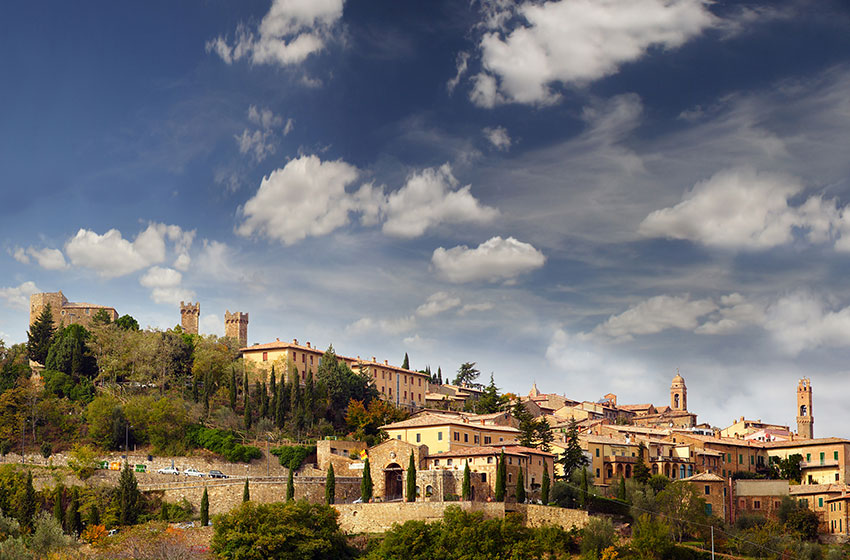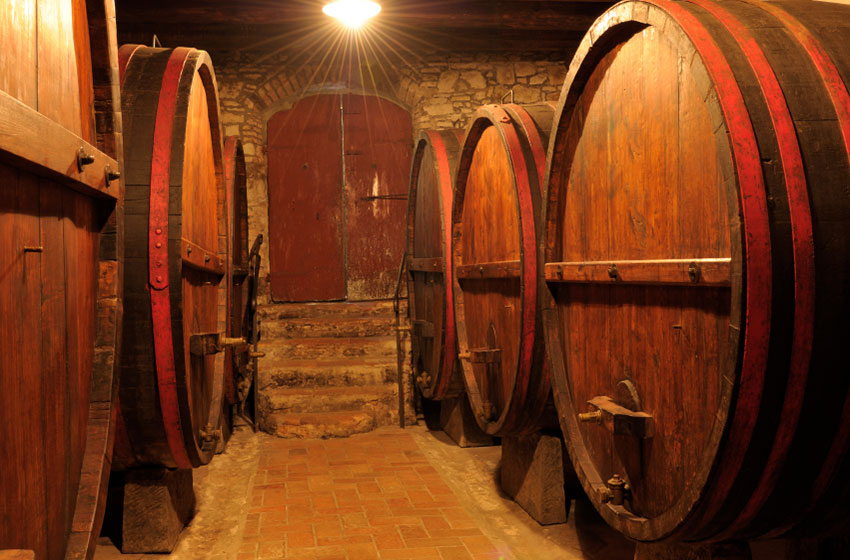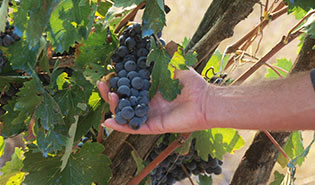Brunello and Montalcino Wine Region
The beautiful hilltop town of Montalcino is located forty kilometers south of the city of Siena, part of UNESCO World Heritage Sites since 2004.
Surprisingly, the distinctive feature of the Montalcino hill is that it is surrounded by forest: vineyards and olive groves are dotted throughout the countryside but only 15% of the area is cultivated with vines. The area is roughly a square, with a surface area of 24,000 hectares bordered by the rivers Ombrone, Asso, and Orcia.



Montalcino’s Terroir
Soil
The hill of the town itself was formed in various geological eras: the oceans receded and returned several times, creating a unique and varied soil mix throughout the area due to its formation over different geological ages. The lowest areas are made up of relatively loose soils. As one moves up the hill, the soil becomes dense with stony particles formed by the decomposition of the original marl and limestone. The nearby Monte Amiata that was once a volcano provides volcanic minerals. The sheer number of different soil types cannot be exaggerated; one producer identified 29 different types in its vineyards alone.

Climate
As the crow flies, Montalcino is 40 km away from the sea and 100 km from the Apennines. The area enjoys a Mediterranean climate with hot and dry summers; rainfall occurs mostly in spring and late autumn (yearly average rainfall: 700 mm) and the days are mostly mild and clear during the growing phase of the grapevines, allowing for a gradual ripening of the fruit. Snow is possible during winter but the dreaded fog, ice, and late frosts are very rare due the blessed wind and ventilation, almost a constant on the hill. Virtually immune to storms and hail, since the Monte Amiata to the south, at 1740 meters, attracts the worst hazards to itself. This cannot be true for ALL the slopes with different exposures, the varying heights from 120 to 650 meters above sea level and therefore the myriad, distinct microclimates created by such diversity, but it is safe to say that Montalcino’s terroir is nothing short of optimal, and that it boasts a nearby, extinct volcano for self-protection.
“Montalcino’s growing zone boasts one of the most complex and varied soil profiles in the world.” Kerin O’Keefe
The History of Brunello Wine
There has been no shortage of wine in Montalcino since the Middle Ages and plenty of visitors have commented on the exceptional quality of the wine throughout the centuries. Brunello, however, is just one of the wines produced on the this hill, owing its fame to the experimentations with a native grape variety started by Clemente Santi and other local farmers in the 19th century. This grape that grew in the surrounding area was known as Brunello, a variety of Sangiovese, that was discovered to give exceptional results when vinified on its own and then aged for a long time in barrels of wood. Santi’s 1865 vintage Brunello was awarded significant international recognition but was known to only a few refined connoisseurs: Brunello wine had to wait another century to transition to an international symbol of the finest Italian wine. Brunello di Montalcino first rose to the ranks of the eight most important Italian wines bearing the DOC designation in 1966, later it became the first wine to be assigned DOCG status in 1980. This superior designation bearing a specific seal from the government still holds true today. The small quantities produced initially made export difficult, but its market became global after 1980 thanks to the growing number of wineries and bottles produced.
The Hill of Holm Oaks
The town’s coat of arms, as well as the Consortium that regulates and promotes Montalcino’s wine production, is represented by a Holm oak. This is because the Montalcino name probably comes from Mons Ilcinus which means the Hill of Holm Oaks

Brunello Wine Today
Today there are more than 200 producers of Brunello di Montalcino DOCG; although all different, their Brunello wines all have something in common, they all dictated by the production regulations which are overseen by the Consortium. Made exclusively from the Sangiovese grapes harvested from licensed vineyards with a controlled, low yield, Brunello wine must age until it can be released to market on January 1st of the fifth year after harvesting. The wine must spend at least two years of this long period in wooden barrels and four months in the bottle, which must be Bordelaise with a natural cork closure. It is not uncommon to find bottles that are much older than that, since one of the great resulting features of these production methods is the wine’s legendary longevity.

The word Brunello comes from the Italian word bruno meaning brown, which is also the Italian word for brunette, and describes the wine’s aged nature: Sangiovese’s bright ruby red color diminishes with time.
Throughout the aging process and in time the wine goes from ruby to garnet, brown and even a terracotta orange with grand old age.
Other Wines from Montalcino
ROSSO DI MONTALCINO DOC
Proof of the great versatility of the Montalcino terroir, the Rosso is made from the same, pure Sangiovese variety used to make Brunello wine, but is a red wine made to be enjoyed sooner with a broadly pleasing character. Rosso di Montalcino can be released to market on September 1st following the year of harvest. It attained DOC status with the 1984 vintage.
SANT’ANTIMO DOC
Exists either as a white or red wine. Starting with the 1996 vintage, it may be produced with any grape varietal authorized in Tuscany. Very interesting quality blends exist, yet the wine can also carry indication of the grape varietals: Cabernet, Merlot and Pinot Nero for Sant’Antimo Rosso and Chardonnay, Sauvignon or Pinot Grigio for Sant’Antimo Bianco.
MOSCADELLO DOC
Moscadello di Montalcino DOC attained DOC status in 1984 and is a historic white dessert wine made from Moscato Bianco, an aromatic grape varietal. Moscadello is produced in three possible variations: Still, Sparkling and Late Harvest. Ranging from straw yellow to golden, Moscadello is praised for its aromatic sweetness and produced in tiny quantities.
Fun Fact

Brunella the Whale
While digging in a vineyard in 2007, Banfi workers uncovered massive proof of the marine life that contributes to Montalcino’s terroir: the skeleton of a prehistoric whale. This 4 million years old creature has been named Brunella and is carefully being cleaned, reassembled and studied by an expert team at the Castello, where incredulous visitors are able to stop by and watch. Finding shark teeth and teeth marks on the skeleton may indicate that Brunella met an untimely end: you can follow #awhaleinavineyard for discovery updates. It is fascinating to see the evidence of events that occurred millions of years ago and to explore how these events shape the wines we enjoy today!
